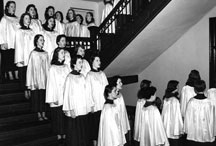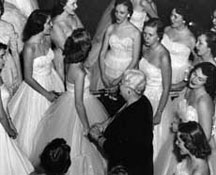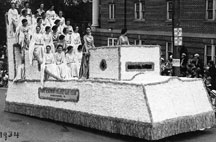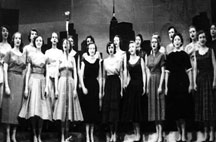
James Madison University's first musical group, the Glee Club, dates back to the institution's first year of operation in 1909-1910.
This chorus was formed in the fall of 1909, when music instructor Lida P. Cleveland organized the Glee Club, with either 14 or 19 members on its first roster (documentation differs on this point).
Although the original Glee Club was designed with “lighthearted socializing in mind rather than serious singing”, the club began performing locally at school assemblies and in tandem with local church choirs. The first major concert was on Arbor Day of 1910. The club also began a tradition of performing at the spring commencement exercises.
One of the Glee Club's long-standing traditions was to close every concert with the song “Old Virginia”, a Commonwealth favorite penned in 1911 by history department head John Wayland and local author William H. Reubush.
Membership grew rapidly throughout 1913-1914, when Paul Hardesty led the ensemble. Hardesty was supervisor of music in the Harrisonburg school system and taught vocal and public school music at the Normal. His humorous motto, “We just open our moufs and hollers,” helped draw more singers into the club.

After Hazel Fay directed the club for a year, Edna T. Shaeffer (after whom Latimer-Shaeffer Theatre is named) took control of the group in 1916.
Shaeffer promptly discarded Hardesty's motto because she thought the phrase wasn't that funny and that the members were not there for laughs but for serious singing. She led the group to earn high esteem for the quality of singing rather than the quantity of members.
Nevertheless, the Glee Club continued to increase its roster, and was just shy of 100 members by 1919. Under Shaeffer's leadership, the group became one of the most active and valuable organizations on campus.
The group grew so large that in 1922 Shaeffer started another vocal ensemble, the Choral Club, so the Glee Club wouldn't be too large and could focus on quality performances. The Choral Club was open to all who were interested in singing and the Glee Club was reserved for the most talented singers.
The Glee Club made its first road trip in 1919 to Lexington , performing to raise money for Jackson Memorial Hospital. After this successful overnight trip, Shaeffer confidently took the Glee Club throughout the Commonwealth. The club sang at then-all-male schools like Washington and Lee and Virginia Military Institute and toured some 30 cities over the years.
World War Was I had a major impact on the Glee Club. The National Council of Defense was promoting music and song in American communities to rally support for the “dough boys” fighting in World War I. National Song Week was created in February of 1919 and Shaeffer was named as Director of Singing for Rockingham County. She formed a Liberty Chorus, organized a contest for the best class song, and taught the Glee Club girls folk songs from the six allied nations.
After the war, the Glee club continued to improve its reputation and earned numerous accolades. It was the first college ensemble in Virginia to join the Virginia Foundation of Music Clubs. The club continued to perform in cities such as Richmond , Norfolk and Roanoke , participated in annual state contests and even performed before the Virginia House of Delegates.

The Glee Club also sang at Apple Blossom Festivals throughout Virginia. These festivals were usually two-day celebrations which included a parade of floats with a Festival Queen in the foremost float.
The Glee Club would sing on one of the floats at this annual festival. When the Harrisonburg State Teacher's College hosted an Apple Blossom Festival in May of 1926, the Glee Club performed the operetta “The Wild Rose.”
In 1931, the Glee Club introduced Madison's new alma mater at a Sunday chapel service. The same year, Glee Club began singing for radio broadcasts on the powerful Richmond radio station WRVA. The Glee Club was heard on the radio from Maryland to Florida throughout the 1930s and 1940s.
One of the most memorable moments for girls singing in the Glee Club was their performance for First Lady Eleanor Roosevelt at the New York World's Fair in 1939.
The Glee Club was profoundly affected by World War II. Travel was curtailed for the singers, so the Glee Club once again turned inward and devoted efforts to raising morale and bolstering support, both on campus and throughout the community.
In February of 1943, a “Victory Revue” was held at Madison College to raise money for the war effort through the sale of defense stamps and war bonds. The Glee Club competed against 16 other campus organizations in a skit contest and won the $25 war bond grand prize for the skit, “Victory Belles,” replete with red, white and blue costumes and a war song medley.

In Schaeffer's last years as director, she saw the Glee Club literally reach new heights. The Glee Club went on an international tour, flying all 60 choristers in Air Force C-54 planes en route to performing for troops stationed at bases in Iceland in 1955 and to Bermuda and the Azores in 1956.
In the domestic portion of this tour, the Glee Club was invited to make an Easter concert tour of military bases along the east coast. That season the club also sang in Miami for the National Federation of Music Clubs.
After Shaeffer's retirement, the club continued to sing under the leadership of Dr. Lester Bucher until 1958. The next year the Glee Club changed its name and became the Madison Concert Choir.
Listen to Madison Glee Club recordings.
-- Alexandra Graham and August Smith
